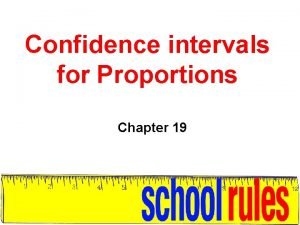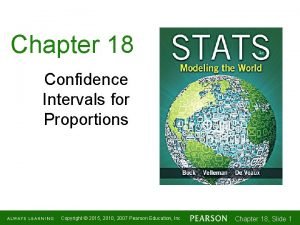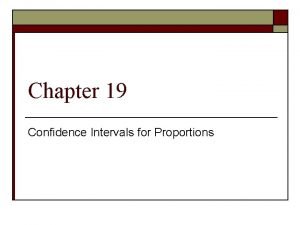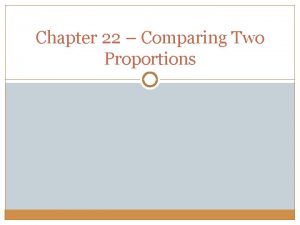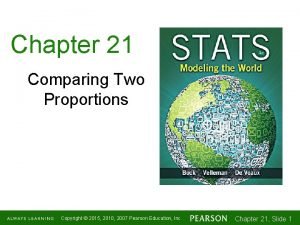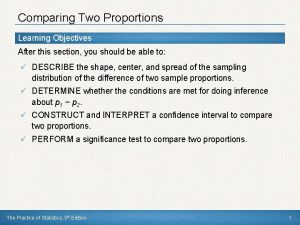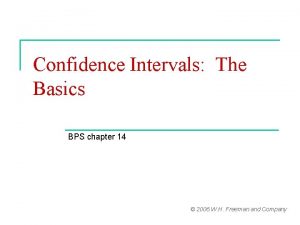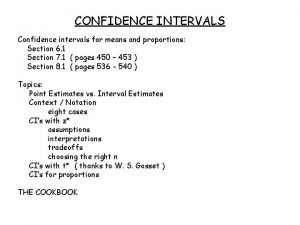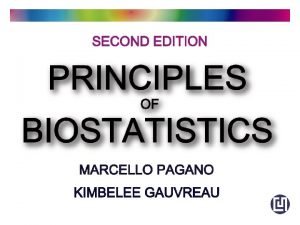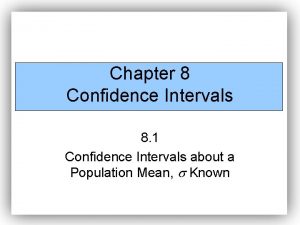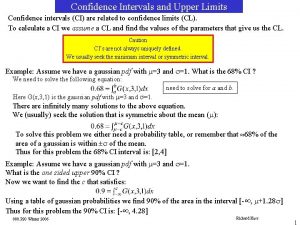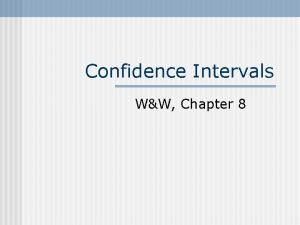Comparing Two Proportions Section 13 2 Confidence Intervals












- Slides: 12

Comparing Two Proportions Section 13. 2

Confidence Intervals Step 1: State what you are looking for…We are looking for the difference in proportions of… Step 2: Conditions *SRS/Random Assignment *Normality: *Independence: Samples are independent of each other

�Step 3: Calculations �Step 4: Conclusions We are ___% confident that the difference in the proportions of…is between…

Example: Data on page 807 Does prayer help in vitro fertilization? �Random assignment into 2 groups: treatment group, where people prayed for them, and a control �Treatment: 44/88 women got pregnant �Control: 21/81 women got pregnant

Example: Does random drug testing reduce illegal drug use? � 2 schools in Oregon: one had random testing and the other did not �Drug testing: 7/135 �No testing: 27/141

2 Proportion Significance Tests Section 13. 2

Step 1: where p 1=… and p 2=…

Step 2: • SRS/Random Assignment • Normality: all must be greater than 5 • Independence: samples are independent

Step 3: Sig Tests of H 0 : p 1 = p 2 use the combined sample proportion: P-value=

Step 4: Interpretation Reject/fail to reject If the proportions were equal, the probability that would obtain a difference of _____ is (p-value)%. We have evidence/ no evidence that…

Example: Seat Belt Use In New York City, police can stop a driver who is not belted. In Boston, police can cite a driver for not wearing a seat belt only if they have been stopped for something else. A random sample of female Hispanic drivers in the two cities shows: City Drivers Belted New York 220 183 Boston 117 68 Conduct a significance test to determine if there is a significant difference in the proportion of drivers wear seat belts in Boston rather than in New York.

Homework: pg. 813 #27 pg. 819 #29, 32
 Critical value for 90 confidence interval
Critical value for 90 confidence interval Chapter 18 confidence intervals for proportions
Chapter 18 confidence intervals for proportions Chapter 19: confidence intervals for proportions
Chapter 19: confidence intervals for proportions Chapter 22 comparing two proportions
Chapter 22 comparing two proportions Chapter 21 comparing two proportions
Chapter 21 comparing two proportions Chapter 22 comparing two proportions
Chapter 22 comparing two proportions Chapter 22 comparing two proportions
Chapter 22 comparing two proportions Chapter 22 comparing two proportions
Chapter 22 comparing two proportions Deveiation
Deveiation Confidence interval vs confidence level
Confidence interval vs confidence level Reporting confidence intervals
Reporting confidence intervals How to find t value for confidence interval
How to find t value for confidence interval Confidence interval excel
Confidence interval excel
